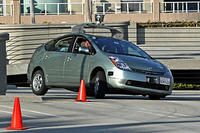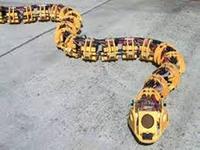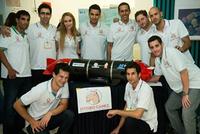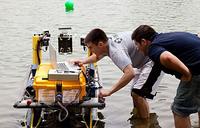-
Navy “mine-hunter” AUV sets mission-endurance record
The U.S. Naval Research Laboratory’s (NRL) Acoustics Division, with Bluefin Robotics, executed a record setting 507 kilometer (315 mile), long-endurance autonomy research mission using its heavyweight-class mine countermeasures autonomous underwater vehicle (AUV), Reliant. NRL’s Reliant AUV, when equipped with a low frequency broadband (LFBB) sonar system, is perhaps best known as the prototype for the new U.S. Navy Knifefish mine-hunter.
-
-
Insects’ way of flying inspires design of tiny flying robots
Researchers have identified some of the underlying physics that may explain how insects can so quickly recover from a stall in midflight — unlike conventional fixed wing aircraft, where a stalled state often leads to a crash landing. The analysis improves the understanding of how insects fly and informs the design of small flying robots built for intelligence gathering, surveillance, search-and-rescue, and other purposes.
-
-
Ann Arbor to offer residents networked, driverless cars by 2021

By 2021, Ann Arbor could become the first American city with a shared fleet of networked, driverless vehicles. This is the goal of the Mobility Transformation Center, a cross-campus University of Michigan initiative that also involves government and industry representatives.
-
-
Developing robots for bridge inspection, mine rescue with NSF grants

In 2011, at Carnegie Mellon University, President Barack Obama announced the National Robotics Initiative. The National Science Foundation announced it has awarded a total of more than $7 million to Carnegie Mellon researchers in the latest round of grants for the initiative — a multi-agency effort to develop robots that can work with humans to extend and augment human skills. Researchers are developing robots for bridge inspection, mine rescue, and aid for the blind.
-
-
Snake robots move quickly in confined spaces, rough terrain

Snakes usually travel by bending their bodies in the familiar S-pattern. When they are stalking prey, however, snakes can move in a straight line by expanding and contracting their bodies. This “rectilinear gait” is slow, but it is quiet and hard to detect—-a perfect way to grab that unsuspecting rodent. This “limbless locomotion” is a highly effective way for a robot to move through cluttered and confined spaces.
-
-
Unmanned undersea platform network to help better deploy naval capabilities
Today’s naval forces rely primarily on highly capable multifunctional manned platforms, such as ships and submarines. Even the most advanced vessel, however, can only be in one place at a time, making the ability to respond increasingly dependent on being ready at the right place at the right time. New Hydra program aims to make it easier, faster, and cheaper to deploy crucial capabilities worldwide.
-
-
Firefighting robot creates 3D images of burning buildings’ interiors for rescuers
Researchers develop novel robotic scouts that can help firefighters to assist in residential and commercial blazes. The robots will map and photograph the interior of burning buildings by using stereo vision. Working together both collaboratively and autonomously, a number of such vehicles would quickly develop an accurate augmented virtual reality picture of the building interior. They would then provide it in near real time to rescuers, who could better assess the structure and plan their firefighting and rescue activities.
-
-
SkySweeper robot inspects power lines easily, cheaply
Mechanical engineers invented a robot designed to scoot along utility lines, searching for damage and other problems that require repairs. Made of off-the-shelf electronics and plastic parts printed on an inexpensive 3D printer, the SkySweeper prototype could be scaled up for less than $1,000, making it significantly more economical than the two models of robots currently used to inspect power lines.
-
-
Humanoid robot ready for DARPA’s Robotics Challenge trials
A Korean research institution joins with nine U.S. universities to enter the team’s DRC-HUBO, a humanoid robot, in DARPA Robotics Challenge (DRC). The competing robots will have to fulfill eight tasks at the competition, among them driving a utility vehicle, walking across rough terrain, climbing a ladder, and using hand tools.
-
-
Tick rover robot kills ticks dead
The day may not be too far away when homeowners can schedule monthly tick clearing service, drastically reducing the risk of tick-borne illness in their pets and children. This is because the “tick rover” robot has just cleared a major hurdle. Testing last month indicated unequivocally that the device kills between 75 and 100 percent of the ticks in its path.
-
-
Young engineers compete in underwater robotics race
Student-built autonomous underwater vehicles will speed through the depths of a Navy pool in a battle for supremacy at the 16th International RoboSub Competition. The competition is being held this week (22-28 July). In addition to building autonomous underwater vehicles, teams are also responsible for creating Web sites and writing journal papers that outline their work.
-
-
Ben-Gurion University student team’s Hydro Camel competes in RoboSub Competition

Today, there are many remotely operated submarines that handle important tasks, such as checking underwater pipelines, mapping underwater minefields, searching for locations to place communication cables, and searching for sunken vessels. These marine vessels, however, are limited by effective communication cables and require frequent human-operator contact. Ben-Gurion University of the Negev is developing a more accurate and effective autonomous, independently thinking underwater vessel that would revolutionize these and other tasks. The BGU entry in the RoboSub Competition is called Hydro Camel.
-
-
Student teams compete in U.S. Navy’s RoboBoat competition

In a race against one another and the clock, robotic boats are battling it out at the 6th International RoboBoat Competition, which began 8 July and ends 14 July. The Office of Naval Research (ONR)-co-sponsored competition takes place on a pond at the Founder’s Inn and Spa in Virginia Beach, Virginia. The event features fifteen student teams racing their custom-designed and built boats.
-
-
DARPA’s disaster robot competition moves to final stage

On Monday, 8 July 2013, the seven teams which progressed from DARPA’s Virtual Robotics Challenge (VRC) arrived at the headquarters of Boston Dynamics in Waltham, Massachusetts to meet and learn about their new teammate, the ATLAS robot. ATLAS is one of the most advanced humanoid robots ever built, but is essentially a physical shell for the software brains and nerves that the teams will continue to develop and refine. The robot will have to perform a series of tasks similar to what might be required in a disaster response scenario.
-
-
Humanoid robot can “see” and build real-time 3D visual maps
Computer vision algorithms that enable Samsung’s latest humanoid robot, Roboray, to build real-time 3D visual maps to move around more efficiently have been developed by researchers from the University of Bristol. By using cameras, the robot builds a map reference relative to its surroundings and is able to “remember” where it has been before.
-
- All
- Regional
- Water
- Biometrics
- Borders/Immig
- Business
- Cybersecurity
- Detection
- Disasters
- Government
- Infrastructure
- International
- Public health
- Public Safety
- Communication interoperabillity
- Emergency services
- Emergency medical services
- Fire
- First response
- IEDs
- Law Enforcement
- Law Enforcement Technology
- Military technology
- Nonlethal weapons
- Nuclear weapons
- Personal protection equipment
- Police
- Notification /alert systems
- Situational awareness
- Weapons systems
- Sci-Tech
- Sector Reports
- Surveillance
- Transportation
Advertising & Marketing: advertise@newswirepubs.com
Editorial: editor@newswirepubs.com
General: info@newswirepubs.com
2010-2011 © News Wire Publications, LLC News Wire Publications, LLC
220 Old Country Road | Suite 200 | Mineola | New York | 11501
Permissions and Policies
Editorial: editor@newswirepubs.com
General: info@newswirepubs.com
2010-2011 © News Wire Publications, LLC News Wire Publications, LLC
220 Old Country Road | Suite 200 | Mineola | New York | 11501
Permissions and Policies
